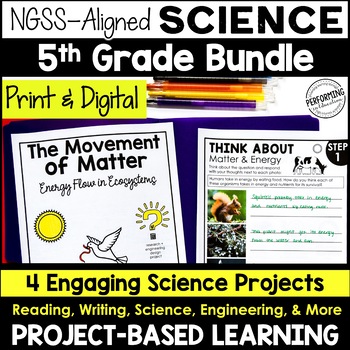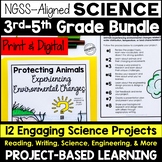5th Grade NGSS-Aligned Project-Based Science | Science PBL | Life Science
What educators are saying
Products in this Bundle (4)
Also included in
- This is a bundle of 12 PBL science units for 3rd-5th grade. These 3-week project-based learning (science-focused) research-based units are the perfect way to teach reading, writing, research skills, and science in one engaging, real-world unit. Your students will use key standards, such as research,Price $58.80Original Price $84.00Save $25.20
Description
This is a bundle of PBL science units for 5th grade. These project-based learning (science-focused) research-based units are the perfect way to teach reading, writing, research skills, and science in one engaging, real-world unit. Your students will use key standards, such as research, reading comprehension, and engineering design in a real-life scenario. The best part about PBL is that student choice and differentiation are built in!
5th Grade Driving Questions:
- How can I construct a model that teaches my classmates about the movement of matter among plants, animals, decomposers, and the environment?
- How can I communicate information on patterns in Earth's systems with people in the community?
- How can I design an experiment to prove to others that the total weight of matter is conserved even when it changes forms?
- How can we create an interactive exhibit showcasing the interaction of Earth's Systems for a science exhibit?
Banish those boring worksheets and get your students excited about real-life learning! These projects cover the following skills:
- Research
- Reading Comprehension
- Collaboration
- Communication
- Writing
- Design & Creativity
- Critical Thinking
- Engineering Design Process
- Data Displays
Included in this Resource:
- Lesson Outline
- Sample Pacing
- Teacher Guide with Lesson Plans
- Scaffolded Research Notes
- Engineering Design Process Overview
- Rubric & Sample Answers
Plus, a BONUS digital version is included as well!
NGSS Standards Covered:
- NGSS.5-LS2-1: Develop a model to describe the movement of matter among plants, animals, decomposers, and the environment.
- 5-ESS1-2: Represent data in graphical displays (bar graphs, pictographs and/or pie charts) to reveal patterns of daily changes in length and direction of shadows, day and night, and the seasonal appearance of some stars in the night sky.
- 5-PS1-2: Measure and graph quantities to provide evidence that regardless of the type of change that occurs when heating, cooling, or mixing substances, the total weight of matter is conserved.
- 5-ESS2-1: Develop a model using an example to describe ways the geosphere, biosphere, hydrosphere, and/or atmosphere interact.
***************************************************************************
Customer Tips:
How to get TPT credit to use on future purchases:
• Please go to your My Purchases page after you log in. Beside each purchase see a Provide Feedback button. Simply click it and you will be taken to a page where you can give a rating and leave a comment for the product. Each time you give feedback, TPT gives you feedback credits that you use to lower the cost of your future purchases. I value your feedback greatly as it helps me determine which products are most valuable for your classroom so I can create more for you.
Be the first to know about my new discounts, freebies and products:
• Click here to follow my store.
*****************************************************************************






